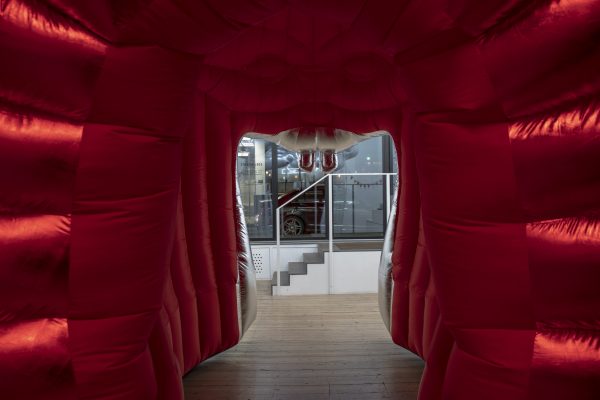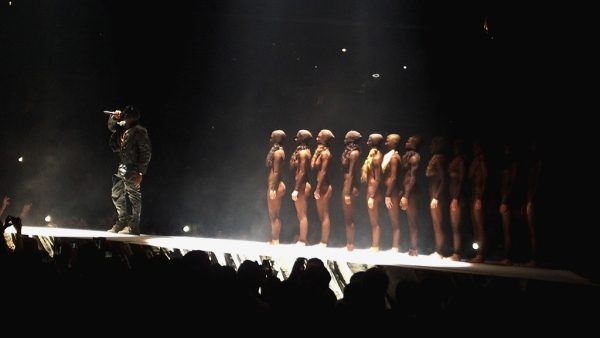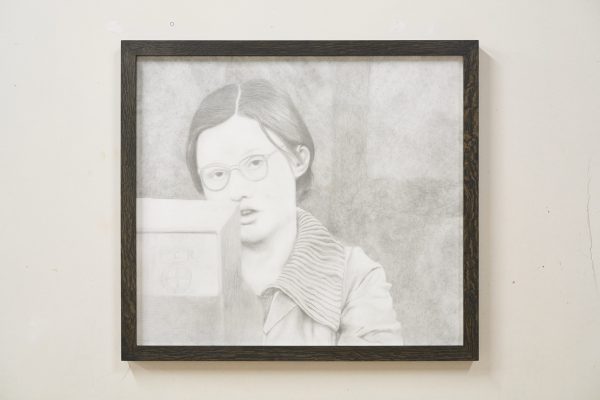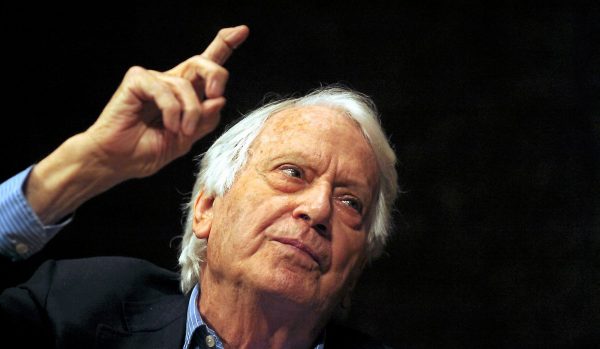Walking into Surrender, Jenkin van Zyl’s installation in which a film loops on the wall of a mock-up of a motel room, I found the space was full of other viewers. Some were lying on beds – just big enough for two, sheets tucked in, pristine white. The atmosphere was strange, informed by the transience and intimacy of the motel room, itself a mirror to one of the locations that appears in van Zyl’s film. There was intimacy here, but uncertainty as well. The uncanny world of Surrender gets under the skin, hinting at the horror that’s to come.
One of the curious things about watching artist films and installations is the ability a viewer has to enter part way through, to engage with imperfect knowledge. Surrender, however, doesn’t stop: there are no endings or opening credits. At the centre of the film is Grace, a human-rat hybrid, who exists as one half of a pair, a fraught union that van Zyl uses as a springboard for several themes. They are referred to as One-Half-of-Grace throughout the film (in each dancing duo, both partners are referred to by a shared name) – the first step Surrender takes in deconstructing ideas of individual identity. Snippets of Grace’s thoughts appear on screen in lines of slanted text, akin to intertitles, propelling the narrative forward.

Grace first arrives at The Marathon, the competition around which the film revolves, via limousine, in which they fall asleep, as fireworks play on a TV screen. The text reveals that entering the competition offers them ‘the chance to redo, to disappear. If only briefly’. The spaces in which The Marathon takes place are perfect for disappearing into: motel rooms; deserted corridors. Even The Ballroom itself, where the actual dancing takes place, has an anonymous quality to it: a stage with a familiar red curtain (the shade matches the dancers’ jumpsuits) and a linoleum dance floor lined with empty tables and chairs. The Ballroom is a nod to ball culture, that decades-old institution of queer activism and escapism. Yet, this ballroom possesses no sense of community, no intimacy.
The other contestants, also pairs of human-rat hybrids, are driven by the possibility of disappearance, too. They all ‘congregated because [they] craved the same thing: escape’ (Grace’s thoughts again). But escape is made complicated by van Zyl. There is a lack of clarity around what these contestants are escaping from; crucially, there is also a lack of clarity about what happens when the escape itself isn’t enough. It’s this moment, in which (in Grace’s words) ‘escape led not to heaven, but back to where we were escaping from’, that captures the tension and uncertainty of Surrender: characters grasping for utopianism that’s undercut by a spectre of violence.

This tension unfolds through the dance itself, as the contestants cling to each other, while seeking for intimacy and protection, while the world around them is dogmatic and cruel. The dancers are kept in constant motion, and authority figures loom over them – from the Floor Referees (white masks, black jackets), who ensure the contestants keep moving, to the ironically named P.A.I.N nurses, who tell them when to slow down and stop. It is through this endless dancing that van Zyl subverts the trope of the dance floor as a site of queer safety or liberation, established in classic gay novels like Andrew Holleran’s Dancer from the Dance (1978) – a mosaic tale of tenuously connected friends, coming together at clubs and parties as they search, if not for love, then at least for beauty – and in records of ball culture, like Paris is Burning (1990).
Van Zyl’s dancers constantly search for intimacy and protection; pairs hold hands while they move, pulling each other close and treating each other’s bodies with delicacy and care. The longer The Marathon goes on, however, the more this care unravels. At times, the contestants hold each other up in spite of their physical and emotional exhaustion, moving together with slow, desperate longing. The contest pushes their bodies beyond their physical limits and, in doing so, also pushes the trope of queer escapism to that same breaking point. As the narrative of Surrender unfolds, it becomes increasingly clear that it’s a uniquely queer piece of horror. The dance floor, a site so often associated with abandon and utopia, is slowly revealed to be nothing but a violently unfulfilled promise.

At the heart of The Marathon is the recurring image of The Rat King, an ominous figure that exists as both a grotesque mood, and a physical, horrific being. The Rat King alludes to the loss of individuality, created through a group of rats fused into one being, their tails knotted together. A large, open-mouthed, inflatable rat is the walkway into the installation, and the presence of the creature casts a shadow over Surrender. One of the most powerful and violent moments in the film comes when, at peak-exhaustion, the dancers try to create their own version of The Rat King. Their tails begin to fuse together and the characters surrender their individuality in a monstrous attempt to create a collective whole. The irony is that The Rat King itself is never fully seen. It exists only as a twisted, grinning visage on arches and trophies that decorate the competition rooms – something to be reborn through The Marathon, perhaps, or a title to be given to The Marathon’s winner, if only for a moment.
There’s a second room in the installation, off to the side of the faux-motel. This smaller room has the same bare, liminal aesthetic of the locations in the film. It’s populated with more trophies celebrating victory or participation, awarded to the dancers in Surrender. All of them are made in the image of The Rat King, and stand on towers of energy drink cans (which the dancers drink in their downtime). The spectre of The Rat King becomes inescapable, bleeding out of the film and into the rest of the world. The image of its frozen, open-mouthed face becomes a shorthand for the endless transformations that animate so much of Surrender, from the fusing of tails to the sight of bodies being broken in the name of spectacle, and van Zyl’s refusal to offer any kind of liberation. At The Victory Ball – the climactic, final day of The Marathon – various dancers collect their trophies or participation prizes. Meanwhile, Grace attempts to escape, tearing their way through a bed that’s been transported into The Ballroom, revealing something strange beyond it. There’s a moment of visceral stillness; Grace is static, staring down into the hole, spit dripping from their open mouth. It turns out that the possibility of escape is mere illusion. The hole in the ground leads Grace through The Rat King’s inflatable head. As they collapse, Surrender loops again.




